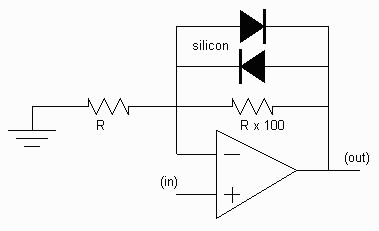|
Overdrive/Distortion
The overdriven sound of a valve amplifier is highly desirable, with
many different output stage designs to produce the variety of trademark
sounds heard on modern recordings. The only problem is that a valve power
amplifier is only capable of producing this sound at one volume (usually,
fairly loud!).
Dummy speaker loads (the good ones are not just resistive, they need
to simulate the reactive load of a speaker) allow a player to use one amplifier
in a variety of playing situations and styles by running the amplifier
at the desired level, and using the dummy load to regulate the volume level.
Another option for the playing musician is to use a variety of amplifiers,
however, this approach appeals only to rare wealthy musicians.
There is much history on the attempts to recreate the desirable overdrive
sounds with various non-linear preamplifier designs.
When a player tests one of these devices, the first impression is usually
formed on the type of overdrive character and tone produced, and players
will be looking for sufficient flexibility in the controls to tailor this
to their personal tastes. The basic types of overdrive are generally classified
as soft and hard clipping.
Soft Clipping.
This is usually marketed as "overdrive", where the gain is inversely
proportional to the input signal level. This is typically produced either
with back to back silicon signal diodes in the negative feedback path of
an op-amp, or with germanium diodes or LEDs back to back in a shunt to
ground.

Hard Clipping.
Usually marketed as "distortion", where the signal level is restricted
within a range. This is typically produced with silicon diodes back to
back in a shunt to ground. This is the same as the circuit above, using
silicon instead of germanium/LED diodes.

There are some other criteria which players will notice (maybe not
immediately) when using these circuits.
The ability to retain timbre.
Different guitar pickup combinations produce recognisable signature
sounds of the instrument used. By its nature, overdrive will mask this
timbre to some extent, however, many musical styles prefer to retain as
much of the original character as possible.
Intermodulation distortion.
Again, by its nature, overdrive will produce intermodulation distortion
when two or more notes are played together. For just two notes played,
intermodulation distortion produces an additional note with a frequency
of the difference between the original two notes. For chords, where up
to 6 notes are played, the combinations of note pairs can produce an unrecognisable
mess of distortion.
On the other hand, this is actually desirable in musical styles which
use mainly power chords, because in this case, the intermodulation distortion
adds a note which is tune with the chord. For other styles, where a player
may want to hold one note and bend (change the pitch of) another, a slurring
bass note occurs which is generally quite undesirable. This can be minimised
to some extent by limiting bass response.
Sustain vs Dynamics.
One of the key desirable features of overdrive is the sustain produced,
however, too much sustain will destroy the dynamics. Players will also
want to use the overdrive sound for single note solo work, and be able
to turn down their guitar volume (effectively reducing the gain of the
overdrive preamplifier) to clean up the sound for chord work. Some designs
are better than others in this ability to compromise sustain and dynamics.
Frequency compensation.
Because preamplifiers are generally connected between the guitar and
the amplifier tone circuit, there is no pickup equalisation to compensate
for reduced treble response. Consequently, it is usual to limit the bass
response before the overdrive section. While it would be logical to boost
it after the circuit, this makes the intermodulation distortion more noticeable,
so this is rarely done.
The overdrive circuit itself adds higher frequency components to the
sound simply because the overdrive circuit is non-linear. These must be
cut to preserve some tone similarity with the unprocessed sound, and to
also remove unwanted high frequency components. Most players prefer this
to be adjustable, to suit their own tastes.
Here is a circuit which combines the desirable
features. Feel free to experiment with the component values. For example,
using lower value capacitors around the tone control (shown below as 0.0068uF)
will give a brighter sound, and vice versa. The capacitor on the left sets
the tone at fully clockwise, while the one on the right sets the minimum
tone sound. Any low-noise dual opamp should be OK; I used a TL072. |

